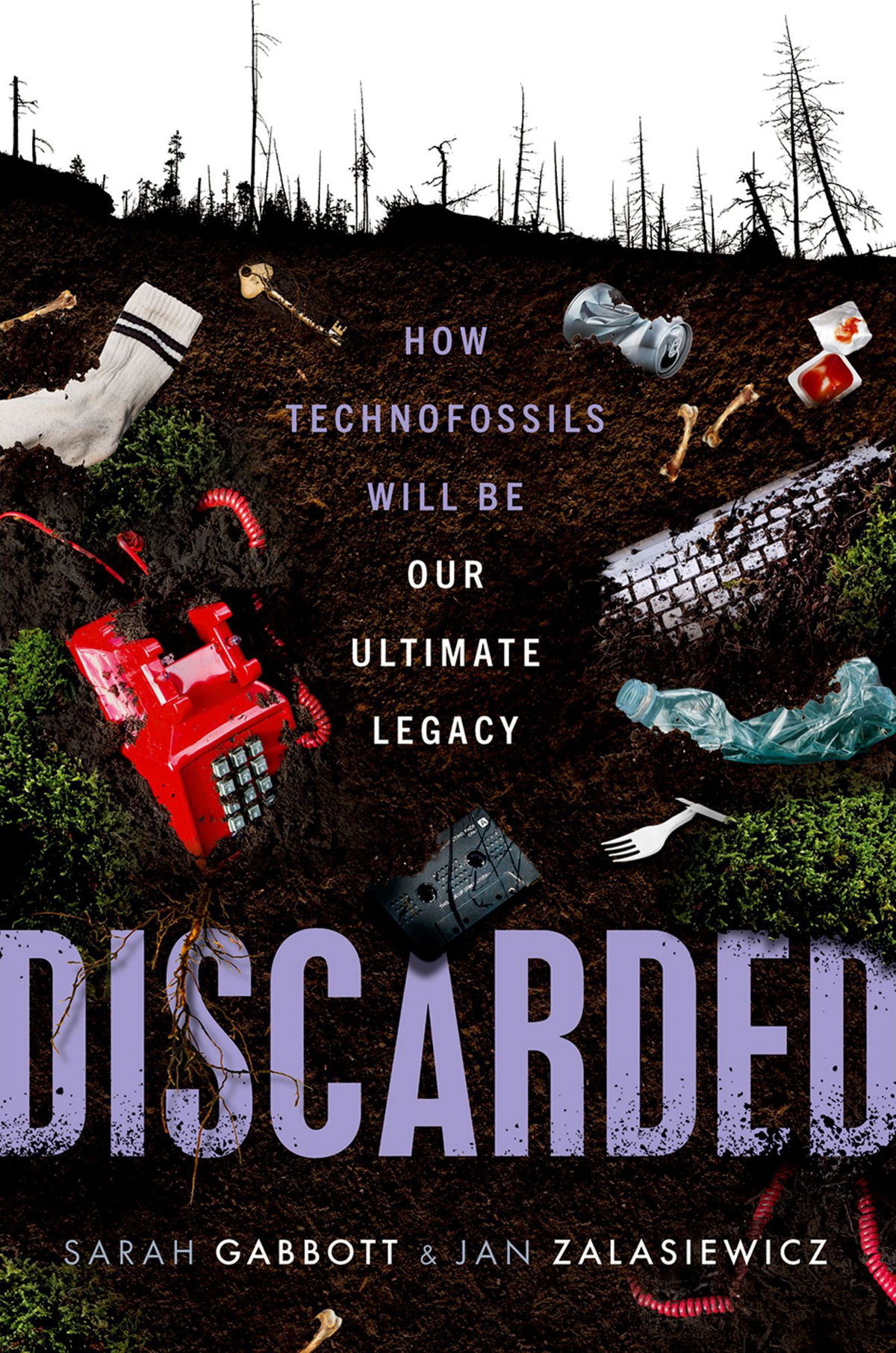These discarded objects will form humanity’s lasting geological footprint, paleontologists say

Plastic may end up as humanity's most enduring legacy
By Katie Hunt, CNN
(CNN) — Imagine the planet tens of millions of years from now. Homo sapiens as a species is likely long gone, wiped out by a mass extinction it helped unleash.
What traces will humanity leave embedded in ancient strata of rock for future paleontologists to detect, study and puzzle over? It’s a question two scientists aim to answer in a new book.
Humankind’s defining testament will be dramatically different from the skeletons, bones and other biological traces that inform today’s fossil record, according to authors Sarah Gabbott and Jan Zalasiewicz, both paleontologists at the University of Leicester in the United Kingdom.
A completely new range of fossils, and a new style of fossilization, is already emerging on Earth, they say. Manufactured objects — plastic bottles, ballpoint pens, concrete buildings, teabags, wind turbines, cell phones, T-shirts, aluminum cans — outweigh the living world and will form distinctive, if sometimes hard to interpret, clues to our existence.
CNN spoke to the authors of “Discarded: How Technofossils Will Be Our Ultimate Legacy” to understand which items from our technology-driven civilization are likely to form the fossils of the future and our everlasting geological signature.
This interview has been edited for length and clarity.
CNN: What was the starting point for this book?
Jan Zalasiewicz: Sarah has spent a career looking at some of the most weird and wonderful and best-preserved fossils, ranging half a billion years back and more, to see exactly how they preserve. I’m also a paleontologist, and I’m involved in this idea of the Anthropocene: that humans are changing the geology of the Earth in a big way.
We worked on the question of what kind of fossils we will leave behind from all the things that we do and make, and what will that tell us? And what might it tell some hypothetical, other beings, let’s say, 100 million years in the future, who might happen upon what we leave behind?
CNN: What are the fossils of the future going to be?
Sarah Gabbott: I think in terms of common items, we have to think about plastics. They are going to be not just found in landfills but found in ocean sediments and pretty much everywhere. Plastic water bottles, for example, we make loads and loads of those. We make 100 billion garments every year, and about 60% of those are plastics-based. In terms of what’s going to be really common, I think things like plastic bottles, plastic bags, ballpoint pens, and so on and so forth. And then also clothing. I think that will be a very distinctive signature.
Clothing is mostly invisible in the archaeological record, and we’re really changing the odds by, instead of wearing stuff that is eminently digestible for all kinds of insects and microbes, suddenly making stuff that is almost completely indigestible. There will be this explosion of stuff, which will be very hard to destroy and will fossilize really easily.
CNN: How easy is it for something to be fossilized?
Gabbott: In terms of fossils of plants and animals, a lot of it is luck. Fossilization is rare. However, you can kind of prime your luck by dying in certain environments. You want to die and get buried in an environment where you get buried really quickly. And if you want to become a super-duper, exceptionally lovely preserved fossil, where all of your soft tissues are preserved, then you want to die in sediments that are anoxic (lacking oxygen) or hypersaline.
I would say that most of the materials that we make actually have a higher preservation potential than organic materials. We’re making these objects and these materials to be super durable, to resist weathering, to resist sunlight, to resist abrasion and not to be eaten by other animals. We’re really giving all these materials a fighting chance of being fossilized. And then we end up sticking loads of them in giant landfills, where we take away water and we wrap them in plastic, and we make them into giant sarcophaguses, which have got really fabulous conditions to help things become fossilized.
CNN: Will it be possible for whole cities to fossilize?
Zalasiewicz: If you’re from a city up in the hills like Manchester, where I come from in northern England, it’s on the Pennines (a UK mountain range), which are very slowly going up. Eventually, no matter what, everything will erode and break down. The detritus will be washed into the sea. There will be clues in that, but you know they’ll be hard (for future paleontologists) to read.
But let’s say you’re in New Orleans and Amsterdam. They are on bits of crust that are sinking in what we call a downward tectonic escalator. At the same time, sea level is rising, so those cities are going to be drowned. What you’ll have is certainly all the kind of substructure stuff, all the pilings, the subway systems and so on. They have a really good chance of surviving more or less intact. Once you’re buried, once you’ve got sediment accumulating on top of you, then the chances of fossilization are really good.
The stuff on top, the skyscrapers and things like that, you would imagine that they would break down into masses of rubble over time. You’d have a kind of rubble layer, part of which will be preserved again, because that’ll be underwater. You will have these megafossils, mega technofossils, which will extend for thousands of square kilometers. I mean, extraordinary.
CNN: Will paleontologists of the future understand what they are seeing when they come across technofossils?
Gabbott: It depends on what they come across. I think they’ll work out pretty quickly there is this enormous kind of junkyard of stuff. And some of the stuff in there will be fairly easy to work out what it was and what it was used for. But other stuff that might be common might actually be really difficult to work out what it was.
A good example of this might be a mobile phone. If you take a smartphone, it’s just a sort of a rectangular object. It’s got a plastic backing, so that will preserve beautifully. It’s got a glass front, but over time, just a couple of thousand years, glass basically starts to go cloudy.
And, in fact, it starts to look quite ceramic. So, there will be this rectangle, and then inside they’ll see different metals. But the smartphone gives very little away in terms of what it was actually used for. They’ll see loads and loads of these things. They will know that it was important to the civilization, but what the hell was it used for? It’s interesting to think they will have an evolutionary series going from old mobile phones that were like bricks, the clamshell ones and then smartphones. Will they figure it out?
Another big signal that our future civilization may come across is where diversity is decreasing. They are going to see masses and masses of the animals that we grow to eat: chickens and the cows. We now know that only 4% of mammals on the planet are wild mammals. It’s astonishing. In fact, in terms of weight, there are more domestic dogs on our planet now than there are wild mammals. They’ll see this massive reconfiguration of the diversity of life.
CNN: Will recycling make the fossils of the future harder to identify?
Gabbott: I think we will start to recycle more and more, and there are plans, or at least some research going on, to look at trying to dig up landfills and take out the materials and recycle those. I think this period of time at the moment is, I hope, going to be the most wasteful time. An aluminum can is a brilliant thing to recycle, but a lot of things are actually quite difficult to recycle. A lot of the plastics that we now use can be recycled once and that’s it, so we’re still going to be getting rid of them. They’ll take those difficult-to-recycle materials and use them for something else. So we’re now grinding up plastic and making roads out of them. There will be this evolution of the way the materials are used.
CNN: What will be the most spectacular technofossils?
Zalasiewicz: The kind of fossil that causes us to catch our breath and start writing the press releases is when you find the feathers trapped in rock, dinosaurs; not just bones, but blood vessels preserved in the bones and things like that. I suspect that we’re creating lots of circumstances where you can get this amazing preservation. We make and throw away lots of stuff like epoxy resin, which will work like amber. We do throw lots of materials into conditions where there is a lack of oxygen, so you slow down decay. One would guess (there will be) wonderful and exceptional preservation here and there that they will happen upon because of the circumstances we’ve produced entirely by accident.
The-CNN-Wire
™ & © 2025 Cable News Network, Inc., a Warner Bros. Discovery Company. All rights reserved.

